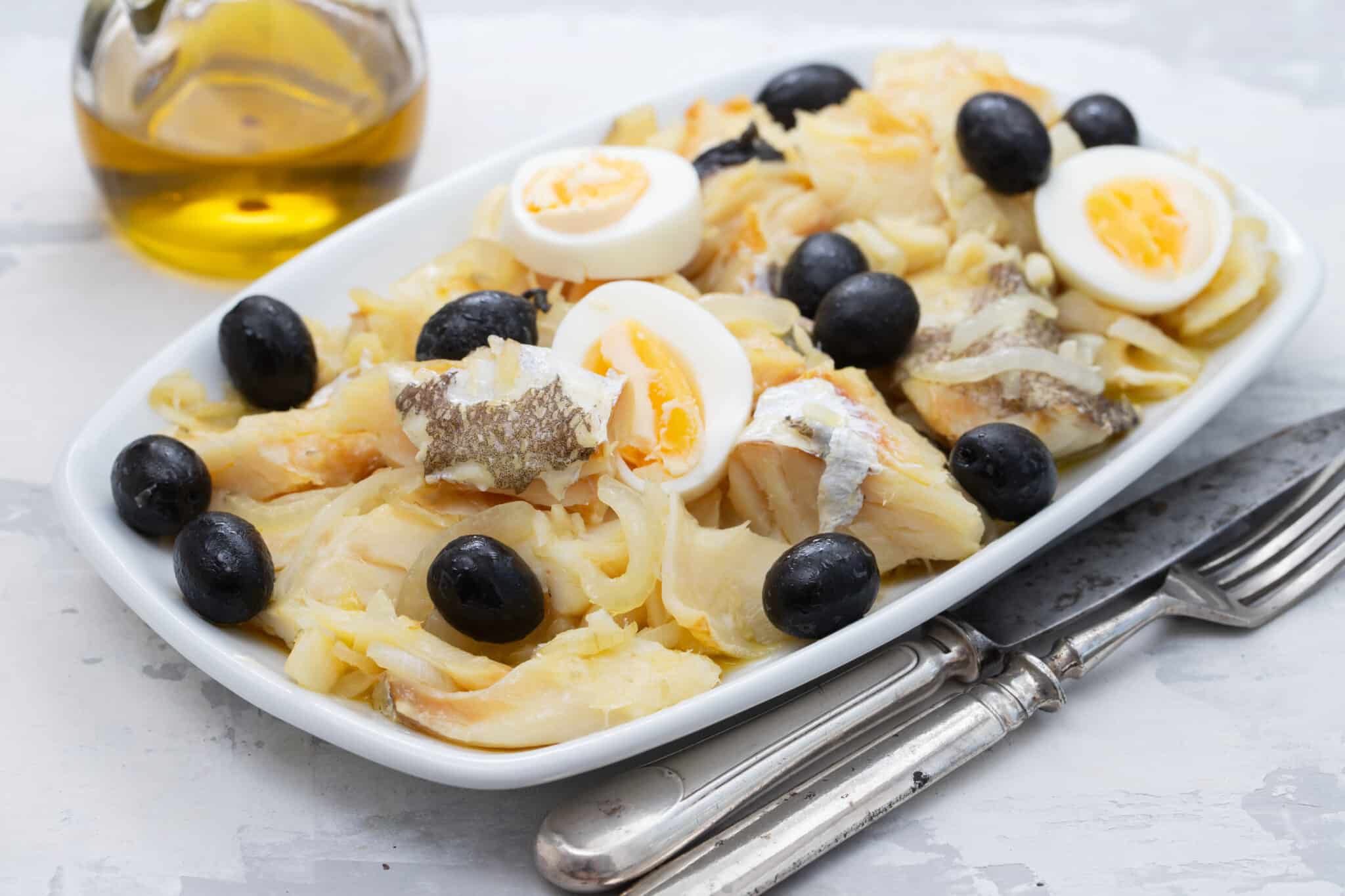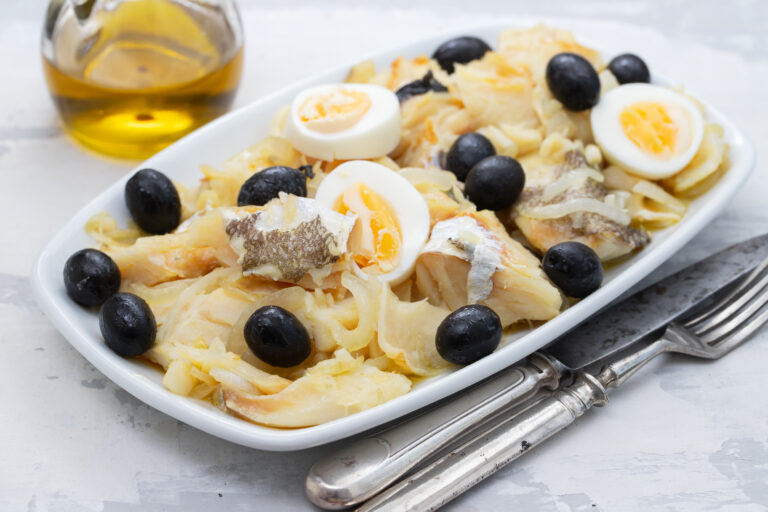
Bacalhau à Gomes de Sá, a national dish of Portugal, is a testament to the country’s rich cultural heritage and love for seafood. Learn more, plus how to make it at home for the ultimate comfort food.
Our team at Remitly created this guide as part of our series that celebrates the cuisine of people around the world.
The Origin Story of Bacalhau à Gomes de Sá
The story behind Bacalhau à Gomes de Sá is as intriguing as its taste. It’s named after its creator, José Luís Gomes de Sá Junior. He was a 19th-century merchant from Porto who sold codfish and had a knack for cooking.
Gomes de Sá passed his recipe down through generations. Today, it remains largely unchanged—a testament to the timeless appeal of this beloved dish.
Key Ingredients in Bacalhau à Gomes de Sá
At the heart of Bacalhau à Gomes de Sá are simple yet flavorful ingredients. The star is salted cod or bacalhau—Portugal’s most favored fish. It’s soaked overnight to remove excess salt and then boiled until tender.
Accompanying the cod are thinly sliced onions and potatoes sautéed in olive oil until golden brown. Hard-boiled eggs, black olives, and parsley add color and depth to this hearty dish.
Traditional Portuguese Bacalhau Recipe
Ingredients:
- 500g bacalhau (salted cod)
- 3 large potatoes, sliced
- 2 onions, thinly sliced
- 4 cloves garlic, minced
- 4 eggs
- 200ml olive oil
- Fresh parsley, chopped
- 100ml white wine
- Salt and pepper to taste
Instructions:
- Preparation of Bacalhau: Bacalhau is a salted cod that is widely used in Portuguese cuisine. To prepare it, you need to soak the bacalhau in cold water for 24-48 hours, changing the water several times. This process helps to desalt the fish. Once ready, shred the bacalhau into pieces.
- Cooking the Potatoes and Onions: In a pan, heat some olive oil and fry the potato slices until they are slightly crispy. Remove and set aside. In the same pan, add the onions and garlic, sautéing until they are translucent.
- Assembling the Dish: In a large baking dish, layer the potato slices, the bacalhau pieces, and the onion-garlic mixture. Repeat the layers until all the ingredients are used up.
- Egg Mixture: Beat the eggs with the white wine, salt, and pepper. Pour this mixture over the bacalhau layers in the baking dish.
- Baking: Preheat your oven to 180°C (350°F). Place the baking dish in the oven and bake for about 25-30 minutes, or until the top is golden brown.
- Serving: Once done, remove from the oven, sprinkle with fresh parsley, and serve while hot.
A Few Notes about the Ingredients and Portuguese Cuisine:
– Bacalhau: The Portuguese are known to have 365 ways of preparing bacalhau, one for each day of the year. It’s a staple in Portuguese gastronomy and is consumed widely, especially during special occasions like Christmas.
– Vinho Verde: This is a unique Portuguese green wine that pairs excellently with seafood dishes. You can enjoy a glass with your bacalhau.
– Other Portuguese Dishes: While bacalhau is a national favorite, there are several other dishes that showcase the rich Portuguese gastronomy. “Arroz de pato” (duck rice), “Francesinha” from Porto, “Caldo verde” (green soup), and the famous “Pastel de nata” (custard tart) are just a few.
This bacalhau recipe brings out the best of Portuguese culinary traditions, reflecting influences from Europe, Africa, and the Atlantic. Enjoy your meal, or as the Portuguese say, “Bom apetite!”
Variations Across Portugal
While the original recipe for Bacalhau à Gomes de Sá is widely appreciated, regional variations exist across Portugal. Some add a touch of creaminess with béchamel sauce, while others introduce a hint of spice with piri-piri peppers.
Regardless of the variation, the essence of Bacalhau à Gomes de Sá remains—the harmonious blend of cod, potatoes, and onions.
How Bacalhau à Gomes de Sá is Enjoyed Today
Today, Bacalhau à Gomes de Sá continues to be a staple in Portuguese homes and restaurants. It’s often enjoyed during festive occasions like Christmas Eve but is equally cherished as a comforting weekday meal.
When it comes to pairing wine with Bacalhau à Gomes de Sá, Portuguese wines are often favored. A crisp Vinho Verde or a full-bodied Douro red can complement the dish beautifully—enhancing its flavors without overpowering them.
For those who prefer beer, a light lager can provide a refreshing contrast to the dish’s hearty nature.
More about Portuguese Food
Portuguese food, deeply rooted in the historic crossroads of Europe, Africa, and the Atlantic, has etched a unique path in the culinary world. From the bustling streets of Lisbon to the serene landscapes of Alentejo and the coastal breezes of Algarve, the nation has birthed a myriad of dishes, delicacies, and flavors that have captured the global palate.
Starting with the coastal regions, Portuguese seafood dishes like arroz de marisco (seafood rice) and polvo à lagareiro (octopus prepared with olive oil and garlic) truly capture the essence of the Atlantic. However, it’s the nation’s love affair with sardines that becomes quite evident, especially during the feast of St. Antony in Lisbon. Streets fill with the tantalizing aroma of sardinhas assadas (grilled sardines), a traditional treat.
Yet, the influence of Portuguese gastronomy stretches far beyond its borders. The era of Portuguese exploration introduced a plethora of ingredients to and from the world. Piri-piri from Africa transformed into piri piri chicken, a spicy and flavorful dish that’s now a household name even in places as distant as the UK and Asia.
Speaking of sausages, Portugal’s chouriço (also known as chorizo in its Spanish counterpart) and alheira (a type of Portuguese sausage originally created by the Jews of Portugal) are standouts. Often smoked and seasoned with paprika, these sausages are delicious when grilled, fried, or even used in a variety of stews.
But Portugal’s influence isn’t just limited to main dishes. The nation’s sweet tooth has also marked its territory worldwide. Convents and monasteries across Portugal once produced an array of desserts using a surprising key ingredient – egg yolks. This led to the creation of the famous pastéis de nata (custard tarts), a crispy, creamy delight that has bakeries from Asia to America trying to replicate its perfection. Its close relative, pastéis de Belém, has queues forming every day in Lisbon for a taste.
And how can we forget Portugal’s beverages? Port wine from Porto, the sweet, fortified wine, has admirers across the globe. Then there’s vinho verde, a crisp, light wine from the northern regions, perfect on a warm day.
In places like Goa, India, Cape Verde, and parts of Africa and South America, the legacy of Portuguese cuisine blends seamlessly with local flavors, creating unique hybrid dishes. Such as the feijoada, originally from Portugal but adapted and transformed in Brazil, mixing both Portuguese and Brazilian ingredients.
Key Portuguese Recipes and Dishes:
- Portuguese Cheese: A delightful array, from the creamy ‘Azeitão’ to the firm texture of ‘Serra da Estrela’.
- Mussels: Commonly prepared in a cataplana, a traditional Portuguese cookware, with garlic, white wine, and herbs.
- Marinade: Essential for dishes like frango (chicken), often involving olive oil, garlic, and traditional spices.
- Suckling Pig (Leitão): Especially popular in the Bairrada region, it’s roasted to crispy perfection.
- Porco Preto: The renowned Iberian black pig, fed primarily on acorns, offering rich and flavorful meat.
- Frango: The ubiquitous chicken, either grilled with piri-piri or cooked in various traditional dishes.
- Shellfish: A cornerstone of Portuguese coastal cuisine, including clams, prawns, and the famous barnacles.
- Bread Roll (Pão): Often served with chouriço or used to make the iconic sandwich, ‘Bifana’.
- Cornbread (Broa): A dense, traditionally made bread, ideal with soups like ‘Caldo Verde’.
- Bacalhau com Natas: A creamy codfish dish, where bacalhau is baked with potatoes, onions, and a luscious cream sauce.
Each of these elements, be it an ingredient, a dish, or a technique, adds a chapter to the rich tapestry of Portuguese culinary heritage.
Visit the homepage, download our app, or check out our Help Center to get started.
